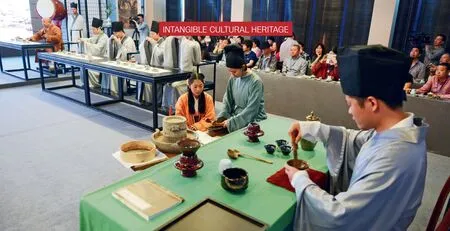Jingshan Tea Ceremony:The Origin of Zen Tea

Visitors are enjoying the whisking tea presentation at the Jingshan Tea Ceremony.
THE Wanshou Zen Temple in Jingshan Mountains,hangzhou City,east China’s Zhejiang Province,is known for its distinctive tea ceremony.It is a tea drinking ceremony combining Zen philosophy and tea culture to honor distinguished guests.The ceremony originated in the middle of the Tang Dynasty (618–907),flourished in the Song (960-1279)and Yuan (1271-1368) dynasties,and was later introduced to Japan where it became the origin of the Japanese tea ceremony.
The beautiful Jingshan District has always been renowned for tea.The“Sage of Tea”Lu Yu of the Tang Dynasty used to stay here,and the place was also the inspiration of his monumental work,The Classic of Tea,the first known book in the world featuring the cultivation,preparation,and drinking of tea.In the Southern Song Dynasty,Emperor Xiaozong once participated in a tea ceremony during his visit to Jingshan and inscribed the words,“Jingshan Xingsheng Wanshou Zen Temple”there.Even after 800 years,the remains of the monument bearing that inscription still stands there.
Tradition has it that when honored guests visit the temple,the abbot will host a tea ceremony to welcome them.A Jingshan tea ceremony encompasses more than 10 procedures,including delivering an opening speech,drum beating,inviting guests into the hall,paying a salute to Buddha and Lu Yu,roasting and whisking tea,distributing tea,and enjoying verses of song and poetry while drinking tea to relax.The essence of the Jingshan tea ceremony is bringing people together to explore the spirit of Zen.
Following the gradual decline of Wanshou Zen Temple after the Qing Dynasty (1644-1911),the tradition of the Jingshan tea ceremony was nearly lost.For a long time,this time-honored ritual only appeared in some historical records.In the 1980s,some influential figures in the Zhejiang tea industry began to restore this traditional ceremony.In 2011,the Jingshan tea ceremony was included in the third batch of China’s national intangible cultural heritage list.
The ceremony normally begins with an opening speech.The abbot makes an opening speech to welcome guests standing at the entrance of the tea hall.Then a monk beats a drum into the hall.Amid the rhythmic drum beats,guests file in the hall and take a seat.After all the guests are seated,the abbot holds lit incenses and makes three bows to two painting scrolls depicting the Buddha and Lu Yu,respectively.Guests also bow along with the abbot to express their sincerity of belief in Zen and as an homage to the Sage of Tea.
Roasting and whisking tea is part of the tea making and also a display of the tea culture.People who are familiar with the tea ceremony know that in the Tang Dynasty people preferred roasting the tea while in the Song Dynasty people fancied whisking tea.The Jingshan tea ceremony includes both ways of tea preparation.
having roasted tea is much more like“eating”it rather than drinking it.First,a small tea disk is roasted on a fire.After that,the disk is ground into powder with a copper roller and sifted with a sieve.Finally,the tea is brewed in water that is brought to boil three times.In order to lessen the bitter taste of tea,mint,salt,red dates,or ginger are often added.
Unlike roasted tea,whisked tea is prepared by whisking tea powder and hot water together until a milk-foam-like layer appears.Before whisking,hot water must be poured into the empty tea ware in the beginning to heat up the container,otherwise the white foam will not form.After that,a small amount of tea powder is scooped into the container and stirred into a paste.Then some hot water is added and a bamboo tea whisk is used to whip the mix until a white foam appears.
When all the tea making procedures have been completed,the monks pour the tea into tea cups and distribute them to all the guests.While tasting the freshly-brewed tea,one of the guests will be invited to the center of the hall to perform the art of calligraphy or compose a poem,which afterwards will be shown to the other guests.After the tea tasting is over,the guests bow to the abbot to thank him for his hospitality,and leave the hall to the beating of drums,which played when they entered.
Set in a quaint tea hall,the Jingshan tea ceremony exemplifies a set of elaborate rituals,a hearty display of hospitality,as well as a custom combining Zen philosophy,etiquette,and tea art.In many respects,it is the quintessential representation of Chinese Zen tea culture.

